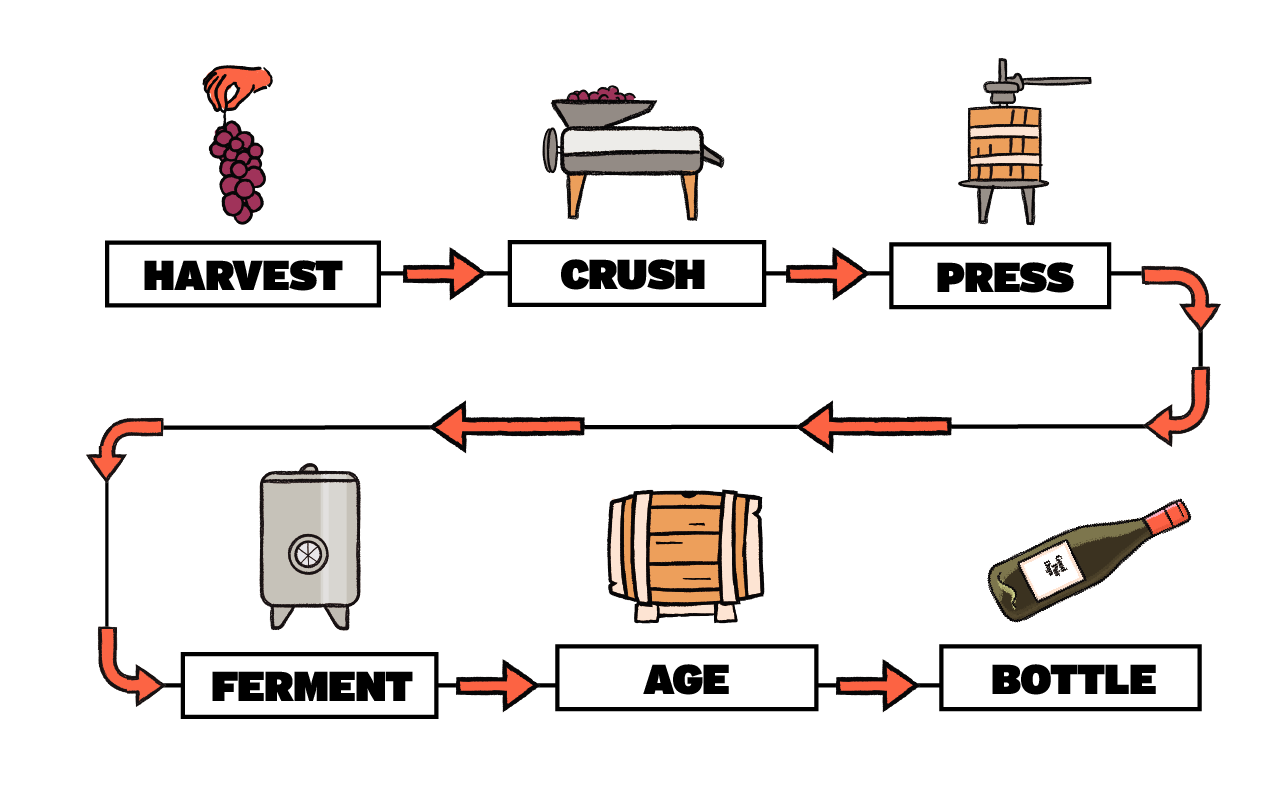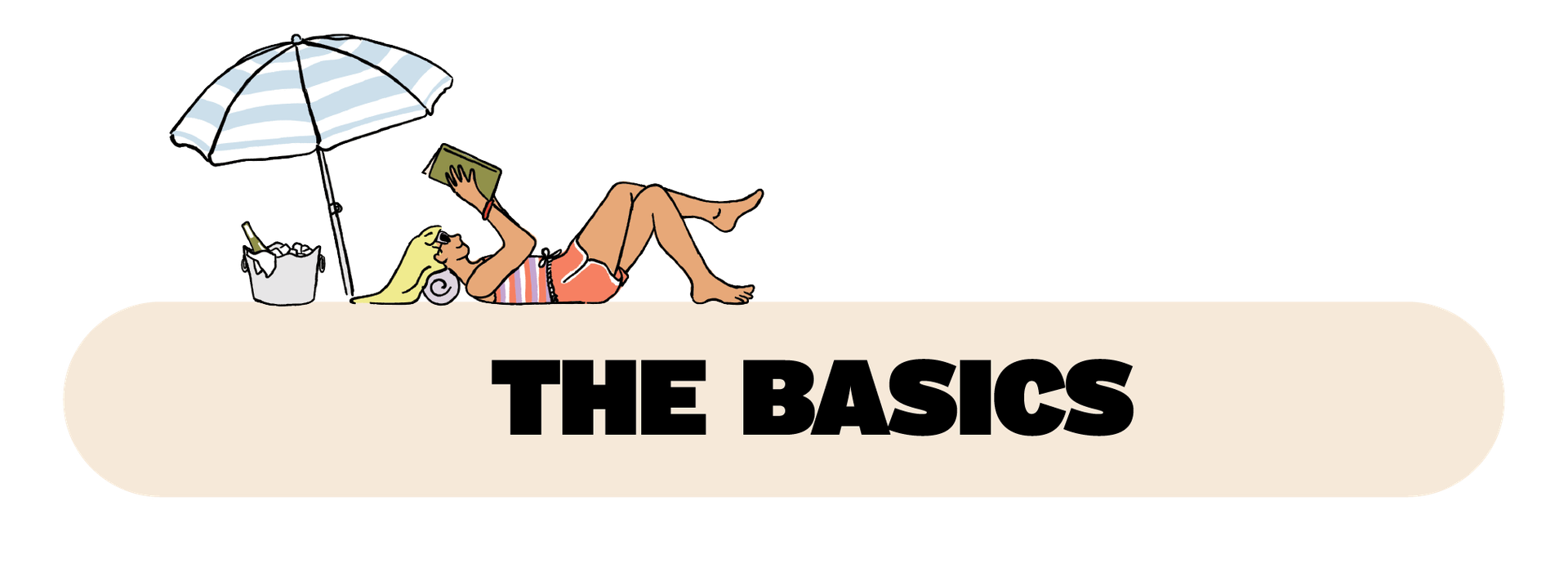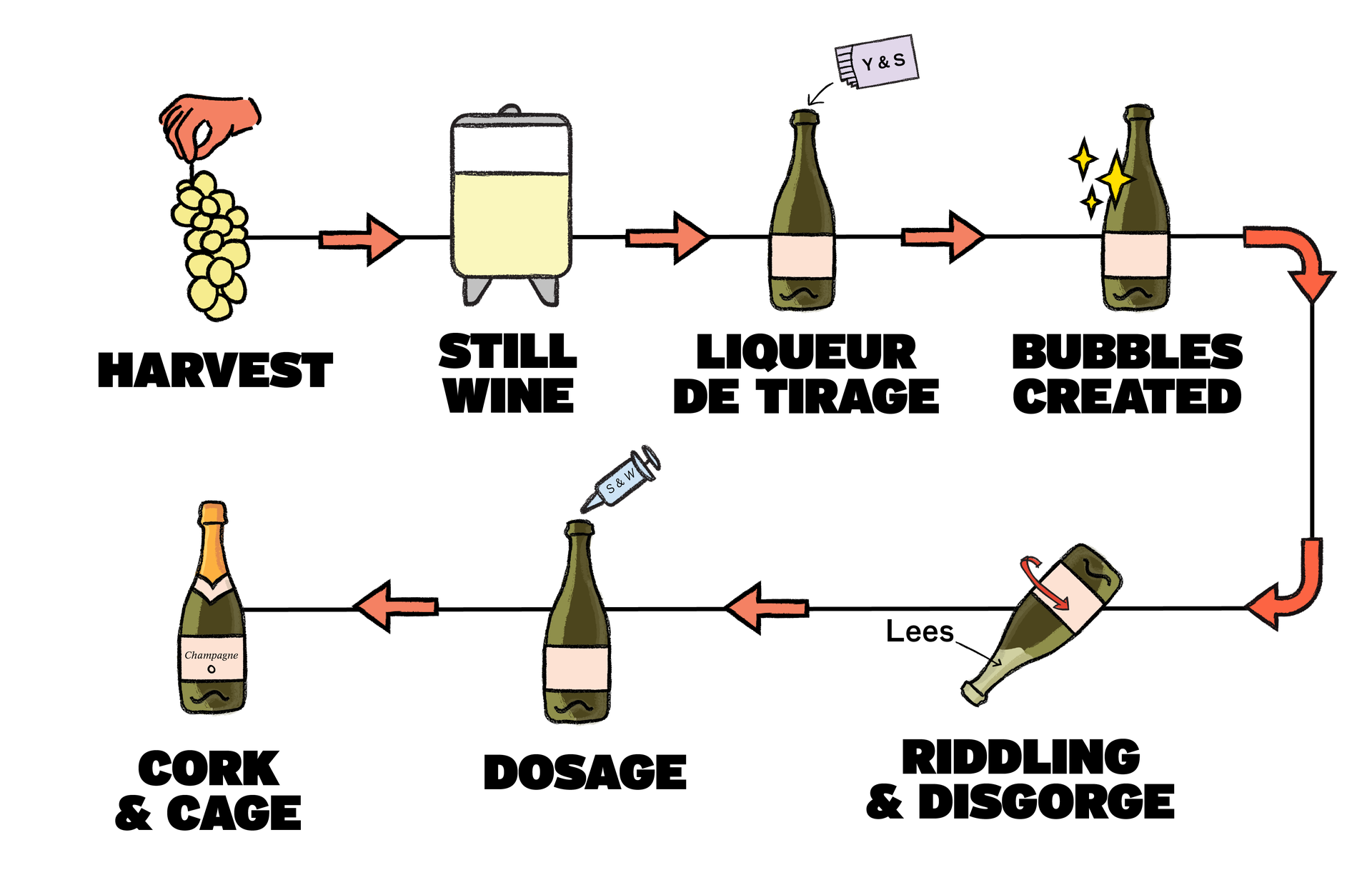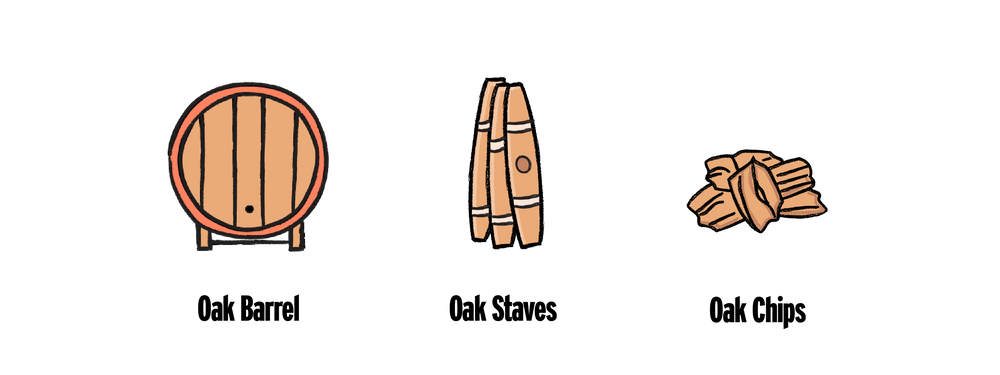

Learn the science and magic of how grapes turn into wine!

Today we are going to take a deep dive into the magic of how grapes turn into wine. And by magic, we mean science. And by science, we mean the kind that is way more fun than it ever was in high school or uni. Crazy hair welcomed, lab coat not required. Pretty sure those coats are white, and we all know that white coats and wine are rarely a recommended combo!
So if you’ve ever wondered where your wine comes from, and how it ended up in the bottle and your glass, here’s a brief introduction to the key steps that lead to all wines, all over the world.
Your wine coaches,
Banjo & Alex

Wine is simply fermented grape juice. So it all starts with the grapes. No matter the wine, the grapes must be as perfect as possible before wine production begins. Once the grapes are healthy and at their optimal ripeness, they are picked and then brought to the winery. At the winery, they are crushed and pressed (to make grape juice!) and then fermented into wine. Boom. Now that we have wine, the wine is left to settle and age for a period of time. Some wines require more or less time ageing. This depends on the intended wine style and local wine laws. Once the wine has reached its optimum expression from ageing (or not ageing), it is time for it to be bottled. Some wines are further aged in the bottle before release.

Now that you know the main steps in making wine, here is a better breakdown of each of these main steps.
Harvest
Once the grapes are fully ripe, they are picked. Some producers use machines to speed up the harvesting, while others choose to pick them by hand.
Crush
Light pressure is applied to the grapes by machine or foot-stomping. This allows the juice of the grapes access to the yeast, tannins, and flavour characteristics of grape skins.
Press
The grapes are pressed to release the juice of the berries and to separate the grape juice from the skins and seeds. This step takes place at different times depending on the style of wine being made, whether it be white, red, rosé or an orange wine.
Ferment
This is the chemical process wherein the sugars of the grape juice slowly turn into alcohol through the aid of yeast. The yeast can be either commercial or naturally present (aka native yeast).
Age
The wine is left to settle in wood vats/barrels or stainless steel tanks. This allows extra character and flavour to develop. Some wines require more or less time ageing, depending on the wine style.

White, Red, and Rosé wines are all equally fermented grape juice. However, each style comes about in a slightly different way.
For example, white wines are not just white because they (mostly) come from white grape types, but rather that they do not spend time macerating on the skins before fermenting. So for white wines, grapes are harvested, then crushed, and pressed to remove the grape skins. Once the grape skins are removed, the juice is allowed to ferment.
Red wines likewise are harvested and crushed, but the freshly crushed juice remains with their own grape skins. This time the juice spends in contact with the grape skins is crucial in the making of red wine. It is because the skins of grapes contain the colour, tannin and many unique flavour aroma compounds that will eventually be expressed in the finished wine. The wine ferments with the skins and then is pressed removing the juice from the skins before ageing and bottling.
Rosé can be a bit of a hybrid of both. Not in the sense that rosé is a blush blend of red and white grapes together (in fact it's rarely made this way), but that rosé wines are made with similar steps to white wine, but with red grapes. That means the red grapes for the rosé wines will be harvested and crushed like white wines, but only spend a brief time on the skins (5-12 hours as opposed to red wine that can spend several days on the skins) to get just a slight touch of colour before being taken off of them. Here are a few different methods to making rosé you can learn more about too.

Wait a second — does this means that you can make a white wine out of red grapes? You got it, smarty pants. This is because the pulp of the grape (that is the inside flesh) of almost all grapes is white. It is the maceration of time with red skins that instead makes the juice red. And it is the tannins that are released from the grape skins that give red wine its tannin structure. Yes, this also means you could also make white wine the same way as a red, by letting it macerate on the skins, and it would result in a white wine with tannin! This is what is done for most Orange wines, aka skin contact wines.

Sparkling wine is also just fermented grape juice. But it gets a touch more complicated as there are actually a few ways to make wine sparkling beyond just one simple fermentation. In fact, some go through two! We'll break down the main methods of making sparkling wine below:
Traditional Method
AKA: Methode Champenoise / Champagne Method / Cap Classique
Surprisingly not the first, but generally considered the best. The Champagne method, which, thanks to the French wine legal eagles must legally be called the traditional method outside the Champagne region, is the classic sparkling vinification process. It is generally believed to make the highest-quality, longest-lived, most complex sparkling wines in the world. It is however also the most expensive, labour-intensive, and time-consuming!
The traditional method requires a secondary fermentation to take place inside the bottle. So a base still wine is made, put into a bottle, and then a mixture of sugar and yeast (known as the liqueur de tirage) is added.
This kicks off a second ferment, resulting in CO2 (yay, bubbles!), a touch more alcohol and finally, dead yeast cells known as lees (again, more on that later!) The wine ages on these lees for a time, creating texture, richness and complexity in the wine.

Before the wine is ready to go however, winemakers will remove the lees by a process called riddling (the French call it remuage). They invert the bottle until the sediment sits in its upside-down neck and can be frozen. When the cap is removed, the bottle’s pressure forces the sediment out, at which point a mixture of sugar and wine called dosage can be added, along with a final cork. Hooray!
Famous examples include Champagne (Champagne, France), Cava (Spain), Cremant (France), Franciacorta (Italy).
Ancestral
AKA: Petillant Naturel / Pet Nat
Ok so we said before that the Champagne method is probably the best if you want your fizz complex and $$$. If you are looking for the OG method, however, this is where you want to land. The ancestral method produces wines called petillant naturel, often called pet nat these days. This is the original method of making wine fizz - no tricks, one ferment, away you go. You can see the Ancestral Method diagram here.
Tank Method
AKA: Charmat Method
This process begins much like the traditional method, with the creation of an uncarbonated (still) base wine. This wine is mixed with the liqueur de tirage, then put in a large stainless steel pressure tank. The yeast and sugar cause a second fermentation in the closed tank, which is held under pressure so the carbon dioxide from the fermentation is forced into the wine!
This method only takes between two and six weeks, after which the fizzy wine is immediately filtered and bottled. That means it's often used for super tasty and fresh styles like Prosecco and many domestic sparkling wines. Great bubbly that's less labour intensive than the traditional method, and ready faster, which means it usually carries a more attractive price tag too.
Famous examples of Tank Method wines are Prosecco (Italy), Sekt (Germany), Moscato d'Asti (Italy)
You can see the Tank Method diagram here.
Carbonation
The simplest method, resulting in the simplest sparkling style. The Wine is made as normal (still base wine), and then force carbonated — ie CO2 gas is forced into the wine.
Since the wine is not given the time to fully integrate these bubbles, the bead of the wine is generally quite coarse and the bubbles don't last as long once the bottle is open. These wines take the least labour and time to make so are typically the least expensive of sparkling wines.
FACT: No, a soda stream cannot make carbonated wine. We tried. It was messy. Good thing we weren't wearing that white lab coat.

As you now know, from vine to winery to bottle, there's a fair bit that can happen. Plenty of decisions along the way, plenty of different actions that can impact the wine and how it tastes.
One of the most common techniques that plays an important role in winemaking that we haven't touched on yet is oak.
Oak barrels are a fundamental part of the maturation process imparting very specific sets of flavours and characteristics to some seriously fine wines.
Traditionally we see oak used in barrel from, but there are other alternative ways to use oak to create different results and meet different price points.

Like all wood, oak contains plenty of chemicals which hold specific aromas, as well as lots of natural tannins. Given time, some of these characteristics soak into the wine which is stored in the barrels, and as the ageing process takes place and the wines round themselves out and soften, the flavours and aromas of the wood begin to blend with those of the wine. From no oak, to a little oak to boatloads of oak it's important to understand oak and its role in winemaking.

There are a few more important things to consider in winemaking too. Consider these like Level 2 Winemaking Techniques. So if you're the nerdy type who likes to skip a grade, we've got more for you to chew on here. We dive into topics like whole bunch fermentation, carbonic maceration to lees stirring to malolactic fermentation and more! If that all seemed like a bunch of jargon, and you're more interested in sipping some sparkling after that detailed dip into bubbly, we don't blame ya! Maybe just star this email and save this read for another time :)

Key Reading
1. How Wine is Made : A general overview.
2. Rosé wine : Learn what makes this style pink and the different ways it attains its rosy hue in the winemaking process.
3. Sparkling Wines: Learn the classic methods of making sparkling wine.
4. Oak and its uses in winemaking
Bonus Reading (for the nerds!)
3. Learn more about other winemaking techniques (Level 2 Winemaking Techniques)
4. Scroll to the bottom of the sparkling wines page to get a glossary of common Sparkling Wine Terms explained.
5. The History of Wine There's some cool info on the history of its making too!
Quiz
Ready to prove your new winemaking knowledge? Take the Chapter 2 How Wine is Made quiz! You'll earn your Chapter 2 Badge as well as 50 points by scoring 7/9 correct!
Homework
The best kind of assignment... tasting!
For today's assignment, take a taste of an oaked wine vs. an unoaked wine. What differences do you notice in the body, texture, tannin and aromas? You will have to use your new tasting skills from class 1 and newly learned theory on oak from today's reading on oak in winemaking to help you determine what to look for!
We recommend trying an oaked and unoaked version of Chardonnay or if you'd prefer red, an oaked vs unoaked Tempranillo.

You did it again! Course 2 of 8 complete. This time we hope you can look at your glass of wine with a fresh set of eyes; to determine what led to its colour or bubbles!
We can't wait to hear how the assignment goes and what new discoveries you uncover! After all, the best way to learn is by tasting. Take that Science class ;)
Happy Wine Learning,
Alex & Banjo
Do you know your wine personality? If your answer is no, take our quiz to find out which wines to pick up next and build your box!
Build my box





